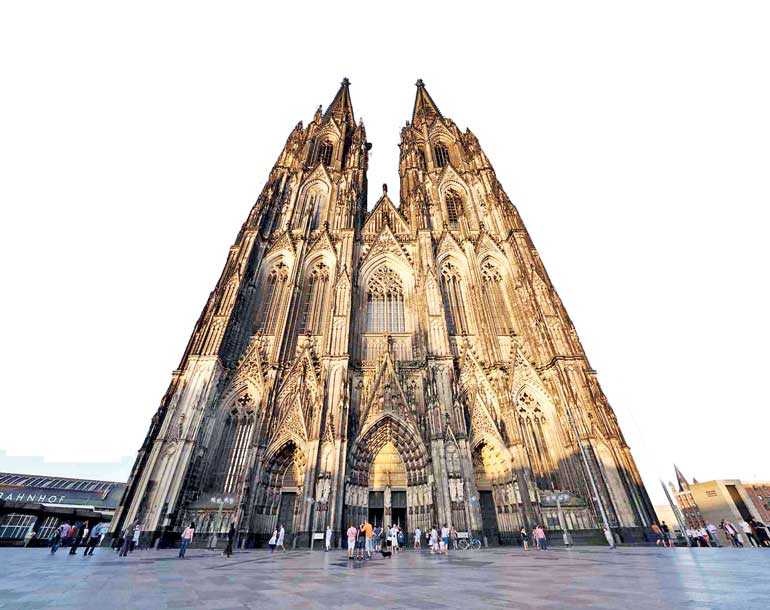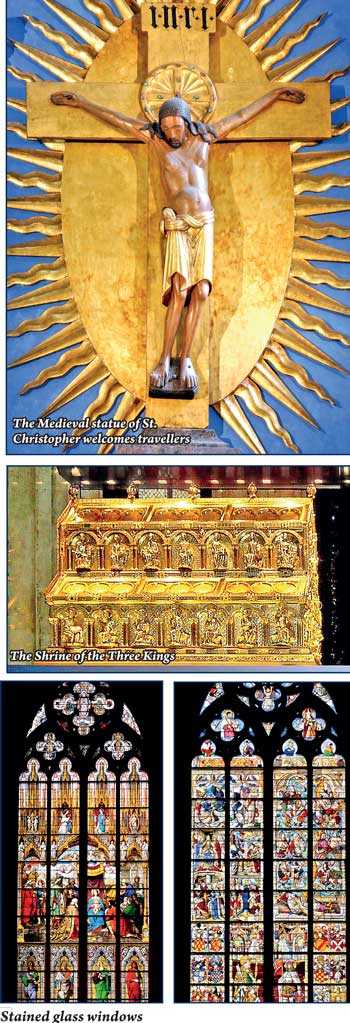Saturday Dec 13, 2025
Saturday Dec 13, 2025
Saturday, 4 May 2019 00:10 - - {{hitsCtrl.values.hits}}

Germany's most visited landmark, Cologne Cathedral has the largest façade of any church in the world
 A splendid testimony of Christian faith, Cologne Cathedral in Cologne, Germany, is a Catholic Church featuring monumental architecture and a spectacular interior.
A splendid testimony of Christian faith, Cologne Cathedral in Cologne, Germany, is a Catholic Church featuring monumental architecture and a spectacular interior.
It took 632 years to complete, but at first glance, the architecture seems to be completely uniform. This is because no generation of builders departed from the original masterplan – even though everyone who began and continued this project was aware that they would never see its completion. They did not build only for themselves, but, inspired by faith, for future generations and for the honour of God. Today, it draws over six million visitors each year from all parts of the world.
Building work began in 1248, but it was not until 1880 that the completion could be celebrated; today, 139 years later, it still takes your breath away at first sight.
A renowned monument of German Catholicism and Gothic architecture, it was declared a World Heritage Site in 1996. It is Germany’s most visited landmark and has the largest façade of any church in the world. The twin-spired church stands at 157 m (515 ft) tall.
This massive cathedral was built to transfer the Magi’s relics from Milan to Cologne in 1164, thus establishing Cologne as one of the most important pilgrimage sites of Europe. At first a golden shrine, still present in the cathedral, was created as precious frame for the relics.
The major part of the preserved objects dates from the years before and after the dedication of the choir in 1322 – amongst them numerous mediaeval altars, windows and sculptures. After building work had come to a standstill in the early 16th century, the unfinished nave and the steeples were eventually completed between 1842 and 1880.
Treasures
One of the treasures of the cathedral is the High Altar, which was installed in 1322. It is constructed of black marble, with a solid slab 15 feet (4.6 m) long forming the top. The front and sides are overlaid with white marble niches into which are set figures, with the Coronation of the Virgin at the centre.
The most celebrated work of art in the cathedral is the Shrine of the Three Kings, commissioned by Philip von Heinsberg, archbishop of Cologne from 1167 to 1191 and created by Nicholas of Verdun, begun in 1190. It is traditionally believed to hold the remains of the Three Wise Men, whose relics were acquired by Frederick Barbarossa at the conquest of Milan in 1164.
The shrine takes the form a large reliquary in the shape of a basilican church, made of bronze and silver, gilded and ornamented with architectonic details, figurative sculpture, enamels and gemstones. The shrine was opened in 1864 and was found to contain bones and garments.
Near the sacristy is the Gero-Kreuz, a large crucifix carved in oak and with traces of paint and gilding. Believed to have been commissioned around 960 for Archbishop Gero, it is the oldest large crucifix north of the Alps and the earliest-known large free-standing Northern sculpture of the medieval period.
In the Sacrament Chapel is the Mailänder Madonna (“Milan Madonna”), dating from around 1290, a wooden sculpture depicting the Blessed Virgin Mary and the infant Jesus. The altar of the patron saints of Cologne with an altar piece by the International Gothic painter Stefan Lochner is in the Marienkapelle (“St. Mary’s Chapel”). Other works of art are in the Cathedral Treasury. The altar also houses the relics of Saint Irmgardis.
Embedded in the interior wall are a pair of stone tablets on which are carved the provisions formulated by Archbishop Englebert II (1262-67) under which Jews were permitted to reside in Cologne.
Cologne Cathedral has two pipe organs by Klais Orgelbau, the Transept Organ built in 1948 and the Nave Organ built in 1998. Cathedral organists have included Josef Zimmermann, Clemens Ganz (1985-2001) and Winfried Bönig (2001).
Visitors can climb 533 stone steps of the spiral staircase to a viewing platform about 100 m (330 ft) above the ground. The platform gives a scenic view over the Rhine.
Medieval beginning
In 1164, the Archbishop of Cologne, Rainald of Dassel, acquired the relics of the Three Kings which the Holy Roman Emperor, Frederick Barbarossa, had taken from the Basilica of Sant’Eustorgio, Milan, Italy. (Parts of the relics have since been returned to Milan.)
The relics have great religious significance and drew pilgrims from all over Christendom. It was important to church officials that they be properly housed, and thus began a building program in the new style of Gothic architecture.
The foundation stone was laid on 15 August 1248, by Archbishop Konrad von Hochstaden. The eastern arm, completed under the direction of Master Gerhard, was consecrated in 1322 and sealed off by a temporary wall so it could be used as the work continued. In the mid-14th century work on the west front commenced under Master Michael. This work ceased in 1473. Some work proceeded intermittently on the structure of the nave between the west front and the eastern arm, but during the 16th century this also stopped.
With the 19th century romantic enthusiasm for the Middle Ages, and spurred by the discovery of the original plan for the façade, it was decided, with the commitment of the Protestant Prussian Court, to complete the cathedral.
Work resumed in 1842 to the original design of the surviving medieval plans and drawings, but utilising more modern construction techniques, including iron roof girders. The nave was completed and the towers were added. The bells were installed in the 1870s. The cathedral has 11 church bells, four of which are medieval. The largest bell is St. Petersglocke.
The completion of Germany’s largest cathedral was celebrated as a national event on 14 August 1880, 632 years after construction had begun. The celebration was attended by Emperor Wilhelm I.
World War II and post-war history
The cathedral suffered 14 hits by aerial bombs during World War II. Badly damaged, it nevertheless remained standing in an otherwise completely flattened city. The twin spires were an easily recognisable navigational landmark for Allied aircraft bombing.
Repairs were completed in 1956, but repair and maintenance work is constantly being carried out in one or another section of the building, which is rarely completely free of scaffolding, as wind, rain, and pollution slowly eat away at the stones. The Dombauhütte, established to build the cathedral and keep it in repair, is said to employ the best stonemasons in the Rhineland.
On 18 August 2005, Pope Benedict XVI visited the cathedral during his apostolic visit to Germany, as part of World Youth Day 2005 festivities.As of 1 March 2017, authorities instituted a ban on large bags in the cathedral in light of recent terrorist attacks in the country.
Architecture
The design of Cologne Cathedral was based quite closely on that of Amiens Cathedral in terms of ground plan, style and the width to height proportion of the central nave. The plan is in the shape of a Latin Cross, as is usual with Gothic cathedrals.
It has two aisles on either side, which help to support one of the very highest Gothic vaults in the world, being nearly as tall as that of the Beauvais Cathedral, much of which collapsed. Externally the outward thrust of the vault is taken by flying buttresses in the French manner.
The choir retains a great many of its original fittings, including the carved stalls, which is made the more surprising by the fact that French Revolutionary troops had desecrated the building. A large stone statue of St. Christopher looks down towards the place where the earlier entrance to the cathedral was, before its completion in the late 19th century.
The nave has many 19th century stained glass windows. A set of five on the south side, called the Bayernfenster, were a gift from Ludwig I of Bavaria, and strongly represent the painterly German style of that date.
Externally, particularly from a distance, the building is dominated by its huge spires, which are entirely Germanic in character, being openwork like those of Ulm, Vienna, Strasbourg and Regensburg Cathedrals.
For Christians, the cathedral is above all a house of God, in which people have congregrated for centuries for worship and prayer. As the church of a Roman-Catholic Bishop, the cathedral is the central church of the Archdiocese of Cologne, with over 2,700 divine services held each year.
